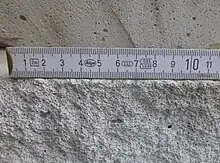
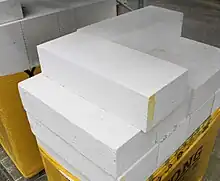
Autoclaved aerated concrete (AAC) is a lightweight, precast, cellular concrete building material, eco-friendly,[1] suitable for producing concrete-like blocks. It is composed of quartz sand, calcined gypsum, lime, portland cement, water and aluminium powder.[2][3] AAC products are cured under heat and pressure in an autoclave. Developed in the mid-1920s, AAC simultaneously provides structure, insulation, and fire- and mold-resistance. Forms include blocks, wall panels, floor and roof panels, cladding (façade) panels and lintels.[4][5] AAC is a highly durable material that can last for many years without requiring maintenance.[2][3][6] It is also an excellent insulator that can help reduce energy costs by keeping buildings cool in the summer and warm in the winter.[2][6] Additionally, AAC is resistant to fire and mold, making it a safe choice for construction.[2][6]
AAC products can be used in almost all construction, such as industrial buildings, residential houses, apartment buildings, and townhouses. Lightweight concrete is used, for example, for exterior and interior walls, firewalls, wet room walls, diffusion-open thermal insulation boards, intermediate floors, upper floors, stairs, opening crossings, beams and pillars. Exterior construction requires some type of applied finish, such as a polymer-modified stucco or plaster compound to guard against the elements, or covered with siding materials such as natural or manufactured stone, veneer brick, metal or vinyl siding.[2] In addition to their quick and easy installation, AAC materials can be routed, sanded, or cut to size on-site using a hand saw and standard power tools with carbon steel cutters.[2][7][8]
Names
Autoclaved aerated concrete is also known by various other names, including autoclaved cellular concrete (ACC), autoclaved concrete, cellular concrete, porous concrete, Aircrete, Thermalite, Hebel, Aercon,[9] Starken, Gasbeton, Airbeton, Durox, Siporex (silicon pore expansion), Suporex, H+H and Ytong.[10][11]
History

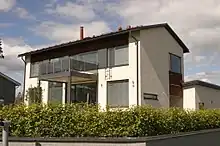
AAC was perfected in the mid-1920s by the Swedish architect and inventor Dr. Johan Axel Eriksson (1888–1961),[12][13] working with Professor Henrik Kreüger at the Royal Institute of Technology.[12][13] The process was patented in 1924. In 1929, production started in Sweden in the city of Yxhult. "Yxhults Ånghärdade Gasbetong" later became the first registered building materials brand in the world: Ytong. Another brand, “Siporex”, was established in Sweden in 1939, and presently licenses and owns plants in 35 locations around the world. The second major international cellular concrete brand, Hebel, goes back to company founder and technician Josef Hebel from Memmingen. In 1943, the first Hebel plant was opened in Germany.
Originally Ytong autoclaved aerated concrete in Sweden was produced with alum shale, whose combustible carbon content was beneficial in the production process. Unfortunately, the slate deposits used for Ytong in Sweden also contain a very low level of natural uranium, which makes the material give off radioactive radon gas in the building. In 1972, the Swedish Radiation Safety Authority pointed out the unsuitability of radon-emitting construction material, and the use of alum slate in the production of Ytong ceased in 1975. By using new formulations, containing only quartz sand, calcined gypsum, lime (mineral), cement, water and aluminum powder, Ytong produced a new type of aerated concrete that no longer contains alum slate and thus has eliminated the problem of radon exposure from this raw material. The production of this white autoclaved aerated concrete is now state of the art and similar formulations are used by all producers around the world.
In 1978, the Swedish team of Siporex Sweden opened the Siporex Factory in the Kingdom of Saudi Arabia – the "Lightweight Construction Company – Siporex – LCC SIPOREX" – which has covered most of the demand from the Middle East, Africa and Japan. The LCC Siporex Factory has operated for more than 40 years. Today, aerated concrete is produced by many companies, particularly in Europe and Asia. There is some production in the Americas, and in Africa there is one plant in Egypt. AAC production in Europe has slowed down considerably, but the industry is growing rapidly in Asia due to strong demand for housing and commercial space. China is now the largest Aircrete market in the world, with several hundred factories. China, Central Asia, India, and the Middle East are the biggest in terms of AAC manufacturing and consumption.[14]
Like other masonry materials, the product Aircrete is sold under many different brand names. Ytong and Hebel are brands of the international operating company Xella, headquartered in Duisburg. Other more internationally renowned brand names in Europe are H+H Celcon (Denmark) and Solbet (Poland).
Uses
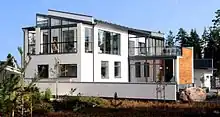

AAC is a concrete-based material used for both exterior and interior construction. One of its advantages is quick and easy installation because the material can be routed, sanded, or cut to size on-site using a hand saw and standard power tools with carbon steel cutters.[2]
AAC is well suited for high-rise buildings and those with high-temperature variations. Due to its lower density, high-rise buildings constructed using AAC require less steel and concrete for structural members. The mortar needed for laying AAC blocks is reduced due to the lower number of joints. Similarly, less material is required for rendering, due to the dimensional accuracy of AAC. The increased thermal efficiency of AAC makes it suitable for use in areas with extreme temperatures, as it eliminates the need for separate materials for construction and insulation, leading to faster construction and cost savings.
Even though regular cement mortar can be used, most of the buildings erected with AAC materials use thin bed mortar in thicknesses around 3.2 millimetres (1⁄8 in), depending on the national building codes. AAC materials can be coated with a stucco or plaster compound to guard against the elements, or covered with siding materials such as brick or vinyl.
Manufacturing

Unlike most other concrete applications, AAC is produced using no aggregate larger than sand. Quartz sand (SiO2), calcined gypsum, lime (mineral) and/or cement and water are used as a binding agent. Aluminum powder is used at a rate of 0.05%–0.08% by volume (depending on the pre-specified density). In some countries, like India and China, fly ash generated from coal-fired power plants, and having 50–65% silica content, is used as an aggregate.
When AAC is mixed and cast in forms, several chemical reactions take place that give AAC its light weight (20% of the weight of concrete) and thermal properties. Aluminum powder reacts with calcium hydroxide and water to form hydrogen. The hydrogen gas foams and doubles the volume of the raw mix creating gas bubbles up to 3 millimetres (1⁄8 in) in diameter—it has been described as having bubbles inside like "a chocolate Aero bar".[16]. At the end of the foaming process, the hydrogen escapes into the atmosphere and is replaced by air.
When the forms are removed from the material, it is solid but still soft. It is then cut into either blocks or panels and placed in an autoclave chamber for 12 hours. During this steam pressure hardening process, when the temperature reaches 190 °C (374 °F) and the pressure reaches 800 to 1,200 kPa (8.0 to 12.0 bar; 120 to 170 psi), quartz sand reacts with calcium hydroxide to form calcium silicate hydrate, which gives AAC its high strength and other unique properties. Because of the relatively low temperature used, AAC blocks are not considered to be a fired brick but a lightweight concrete masonry unit. After the autoclaving process, the material is ready for immediate use on the construction site. Depending on its density, up to 80% of the volume of an AAC block is air. AAC's low density also accounts for its low structural compression strength. It can carry loads of up to 8,000 kPa (1,200 psi), approximately 50% of the compressive strength of regular concrete.
In 1978, the first AAC material factory - the LCC Siporex- Lightweight Construction Company - was opened in the Persian Gulf state of Saudi Arabia, supplying Gulf Cooperation Council countries with aerated blocks and panels. Since 1980, there has been a worldwide increase in the use of AAC materials. New production plants are being built in Australia, Bahrain, China, Eastern Europe, India and the United States. AAC is increasingly used worldwide by developers.
Reinforced autoclaved aerated concrete
Reinforced autoclaved aerated concrete (RAAC) is a reinforced version of autoclaved aerated concrete, commonly used in roofing and wall construction. The first structural reinforced roof and floor panels were manufactured in Sweden, soon after the first autoclaved aerated concrete block plant started up there in 1929, but Belgian and German technologies became market leaders for RAAC elements after the Second World War. In Europe, it gained popularity in the mid-1950s as a cheaper and more lightweight alternative to conventional reinforced concrete, with documented widespread use in a number of European countries as well as Japan and former territories of the British Empire.[17][18]
RAAC was used in roof, floor and wall construction due to its lighter weight and lower cost compared to traditional concrete,[19] and has good fire resistance properties; it does not require plastering to achieve good fire resistance and fire does not cause spalls.[20] RAAC was used in construction in Europe, in buildings constructed after the mid-1950s.[21][22] RAAC elements have also been used in Japan as walling units owing to their good behaviour in seismic conditions.
RAAC has been shown to have limited structural reinforcement bar (rebar) integrity in 40 to 50 year-old RAAC roof panels, which began to be observed in the 1990s.[22][23][24][25][26] The material is liable to fail without visible deterioration or warning.[22][26] The material is not the root cause, rather inadequate roof maintenance, which permits water infiltration, and decisions by building owners as to repair or the replacement of existing roofs, which is a part of cost-benefit analysis.[27]
Professional engineering concern was publicly raised within the United Kingdom in 1995 about the structural performance of RAAC following inspections of cracked units in British school roofs,[28] with it being observed that it was likely that RAAC in other countries may exhibit problems similar to those found in the United Kingdom.[18]
Eco-friendliness
The high resource efficiency of autoclaved aerated concrete ensures its low environmental impact at all stages of its life cycle, from raw material processing to the disposal of aerated concrete waste. Due to continuous improvements in efficiency, the production of aerated concrete blocks requires relatively little raw materials per m3 of product and is five times less than the production of other building materials.[29] There is no loss of raw materials in the production process, and all production waste is returned to the production cycle. Production of aerated concrete requires less energy than for all other masonry products, thereby reducing the use of fossil fuels and associated carbon dioxide (CO2) emissions.[30] The curing process also saves energy, as the steam curing takes place at relatively low temperatures and the hot steam generated in the autoclaves is reused for subsequent batches.[31][32]
Advantages
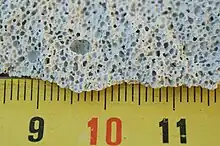
AAC has been produced for more than 70 years and has several advantages over other cement construction materials, one of the most important being its lower environmental impact.
- Improved thermal efficiency reduces the heating and cooling load in buildings.
- Porous structure gives superior fire resistance.
- Workability allows accurate cutting, which minimizes the generation of solid waste during use.
- Eco-friendly in nature not producing pollution in the environment and contributes to LEED rating green building material.[1]
- Resource efficiency gives it lower environmental impact in all phases from the processing of raw materials to the ultimate disposal of waste.[1]
- Being lighter in weight the blocks can be handled easily. The lighter weight saves cost and energy in transportation, labour expenses, and increases chances of survival during seismic activity.[33]
- Larger size blocks lead to faster masonry work.
- Reduces project cost for large constructions.
- Fire-resistant: AAC, like other concretes, is fire-resistant.
- Good ventilation: This material is very airy and allows the diffusion of water, reducing humidity inside the building. AAC absorbs moisture and releases humidity, helping to prevent condensation and other problems related to mildew.
- Non-toxic: There are no toxic gases or other toxic substances in autoclaved aerated concrete. It does not attract rodents or other pests, and cannot be damaged by them.
- Accuracy: Panels and blocks made of autoclaved aerated concrete are produced to the exact sizes needed before leaving the factory. There is less need for on-site trimming. Since the blocks and panels fit so well together, there is less use of finishing materials such as mortar.
- Long-lasting: The life of this material is longer because it is not affected by harsh climates or extreme weather changes, and will not degrade under normal climate changes.
Disadvantages
AAC has been produced for more than 70 years. However, some disadvantages were found when it was introduced in the UK (where double-leaf masonry, also known as cavity walls, are the norm).
- The process of using AAC is somewhat complex, so builders have to undergo special training.[34]
- Non-structural shrinkage cracks may appear in AAC blocks after installation in rainy weather or humid environments. This is more likely in poor-quality blocks that were not properly steam-cured. However, most AAC block manufacturers are certified and their blocks are tested in certified labs, so poor-quality blocks are rare.[35]
- Has some brittle nature: requires more care than clay bricks to avoid breakage during handling and transporting.
- Fixings: the somewhat brittle nature of the blocks requires longer, thinner screws when fitting cabinets and wall hangings. Special wall fasteners (screw wall plug anchors) designed for autoclaved aerated concrete including gypsum board and plaster tiles are available at a higher cost than standard expandable wall plugs, including special safety-relevant anchors for high load bearing;[36][37][38] It is recommended that fixing holes be drilled using HSS drill bits at a steady constant speed without hammer action.[36][37] Masonry drill bits and standard expandable wall plugs are not suitable for use with AAC blocks.[37]
- Using European standard density (400 kg/m3, B2,5) AAC blocks alone would require very thick — 500 mm or thicker — walls to achieve the insulation levels demanded by newer building codes in Northern Europe.[34]
References
- 1 2 3 "AAC Blocks". Copenhagen: UN Climate Technology Centre and Network. 8 October 2018. Retrieved 12 July 2023.
- 1 2 3 4 5 6 7 "Autoclaved Aerated Concrete". Washington: Portland Cement Association. Retrieved 12 July 2023.
- 1 2 "Autoclaved Aerated Concrete". Mumbai: Bennett & Coleman Ltd. Retrieved 12 July 2023.
- ↑ "Autoclaved Aerated Concrete". www.cement.org. Retrieved 28 November 2018.
- ↑ "Products specifications - AIRCRETE". aircrete-europe.com. Archived from the original on 2 April 2015. Retrieved 16 July 2014.
- 1 2 3 "Autoclaved aerated concrete (AAC)". Victoria: Connection Magazines. Retrieved 11 July 2023.
- ↑ "AAC can bring down construction cost by up to 20 percent". Indian Cement Review. 31 October 2015.
- ↑ "Using Autoclaved Aerated Concrete Correctly". Masonry Magazine. 1 June 2008. Retrieved 28 November 2018.
- ↑ "Aercon Florida, USA".
- ↑ "History of Autoclaved Aerated Concrete". Oldenzaal: AIRCRETE EUROPE. 26 September 2018. Retrieved 11 July 2023.
- ↑ "What is worth knowing about cellular concrete?". Brzeg Dolny: PCC Group. 23 August 2022. Retrieved 12 July 2023.
- 1 2 "Hebel: The History of AAC". Archived from the original on 4 November 2010.
- 1 2 Berg, Samuel A (2004). "Pionjärinsatser i betongens barndom - Konstruktionsbetongens historia 1890-1950" [Swedish Association of Historical Buildings: Pioneering work in the early days of concrete - history 1890–1950]. Byggnadskultur (in Swedish) (4/2004). Archived from the original on 25 May 2012. Retrieved 9 February 2021.
- ↑ "AAC India". Archived from the original on 24 March 2013. Retrieved 11 March 2013.
- ↑ "Jämerä Sämsö Seinäjoki 2016" (in Finnish). Espoo: Jämerä Kivitalot Oy. 2016. Retrieved 26 July 2023.
- ↑ Triggle, Nick (25 May 2023). "Five hospitals at risk of collapse to be rebuilt". BBC News. Retrieved 25 May 2023.
- ↑ "Expert reaction to situation with RAAC in school buildings". Science Media Centre. Retrieved 6 September 2023.
- 1 2 "Industry experts speak on RAAC". International Construction. 5 September 2023. Retrieved 6 September 2023.
- ↑ "What is RAAC concrete and how many schools are affected?". BBC News. 31 August 2023. Retrieved 1 September 2023.
- ↑ Buekett, J; Jennings, B. M. (1966). Reinforced Autoclaved Aerated Concrete. London: The Concrete Society. pp. 1–23.
- ↑ Goodier, Chris; Cavalaro, Sergio; Lee, Kelvin; Casselden, Rebe (30 June 2022). "Durability variations in reinforced autoclaved aerated concrete (RAAC) – extended abstract". EDP Sciences. MATEC Web of Conferences. 361: 06005. doi:10.1051/matecconf/202236106005. S2CID 250201723. Retrieved 11 July 2023.
- 1 2 3 Goodier, Chris (17 March 2023). "Expert explainer: What is Reinforced Autoclaved Aerated Concrete (RAAC) and why are people concerned about it?". Loughborough: Loughborough University. Retrieved 11 July 2023.
- ↑ "Children At Risk In Schools Where Concrete Could Collapse". Itv.com. 16 March 2023.
- ↑ "Reinforced autoclaved aerated concrete: estates guidance". GOV.UK. 31 August 2023.
- ↑ "What is the problem with Reinforced Autoclaved Aerated Concrete (RAAC)?". Surveyors to Education. 8 April 2021. Retrieved 16 March 2023.
- 1 2 "Information on Reinforced Autoclaved Aerated Concrete (RAAC)". Local Government Association (UK). Retrieved 1 September 2023.
The LGA is advising its members to check as a matter of urgency whether any buildings in their estates have roofs, floors, cladding or walls made of Reinforced Autoclaved Aerated Concrete (RAAC)
- ↑ Tagg, Adrian; Purnell, Phil (1 September 2023). "Expert reaction to situation with RAAC in school buildings". SMC. London: The Science Media Centre. Retrieved 3 September 2023.
- ↑ Victor Whitworth (21 February 1995). "Verulam column: Relying on British Standards". The Structural Engineer. 73 (4): 68.
- ↑ Hertwich, Edgar G.; Ali, Saleem; Ciacci, Luca; Fishman, Tomer; Heeren, Niko; Masanet, Eric; Asghari, Farnaz Nojavan; Olivetti, Elsa; Pauliuk, Stefan; Tu, Qingshi; Wolfram, Paul (16 April 2019). "Material efficiency strategies to reducing greenhouse gas emissions associated with buildings, vehicles, and electronics". Environmental Research Letters. 14 (4): 043004. doi:10.1088/1748-9326/ab0fe3. hdl:1721.1/134640. S2CID 159348076. Retrieved 10 October 2022.
- ↑ "Autoclaved Aerated Concrete (AAC) A Sustainable Building Material". globenewswire.com (Press release). 11 January 2018. Retrieved 10 October 2022.
- ↑ "Production of environmentally friendly aerated concrete with required construction and operational properties" (PDF). matec-conferences.org. Retrieved 10 October 2022.
- ↑ Decorative Concrete Guide
- ↑ "AAC India - Advantages of using AAC". Archived from the original on 4 October 2013. Retrieved 3 October 2013.
- 1 2 Princy, A.J. (3 May 2021). "India AAC blocks and Non-Reinforced Panels: A Concise Guide". Pune: Research Dive. Retrieved 12 July 2023.
- ↑ "Cracks in AAC Blocks Wall – Causes and Repair". Navsari: Gharpedia. 28 February 2022. Retrieved 28 July 2023.
- 1 2 "Fixing Guide for greencon AAC Blockwalls". Shah Alam: RFM Construction Products. Retrieved 16 July 2023.
- 1 2 3 "Concrete Blocks Technical Guidance: Fixings". Flimby: Thomas Armstrong (Concrete Blocks). Retrieved 16 July 2023.
- ↑ "Aircrete Booklet" (PDF). January 2012. Archived from the original (PDF) on 4 June 2016.
External links
 Media related to Autoclaved aerated concrete at Wikimedia Commons
Media related to Autoclaved aerated concrete at Wikimedia Commons- History of Autoclaved Aerated Concrete
- Using Autoclaved Aerated Concrete Correctly - Masonry Magazine, June 2008
- Aircrete Products Association
- Autoclaved Aerated Concrete - Portland Cement Association